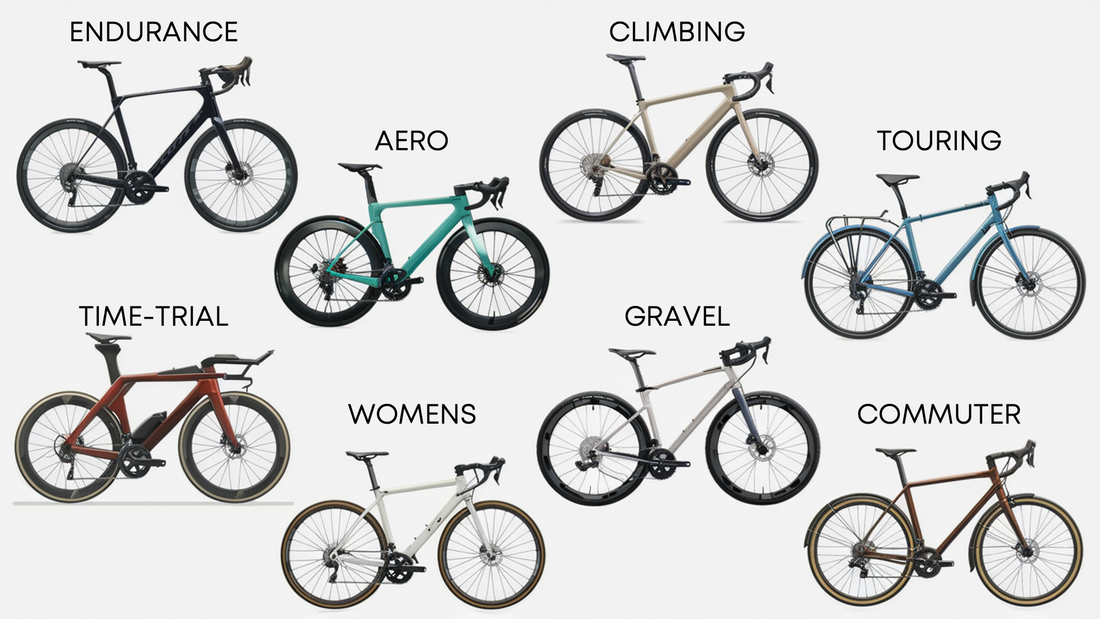
Road-Bike Frame Types
Share
The road-bike frame is the heart of your bike, dictating its performance, comfort, and suitability for your cycling style. Frames come in different types, sizes, and materials, each tailored to specific riding goals. Selecting the right frame involves understanding its geometry, components, and material characteristics.
a. Parts of a Road-Bike Frame
A road-bike frame comprises key components, including the top tube, down tube, seat tube, chainstays, and fork. The geometry of the frame depends on the lengths of these parts and influences the bike’s stiffness, comfort, and handling.

Practical Tip: Take manufacturers’ guides for sizing with a pinch of salt. A very useful tool is the ability to compare size charts and understand the differences. For example, the geometry of modern bikes is often designed for an aggressive style, meaning manufacturer recommendations frequently result in reaches that are too large for many people. When in doubt, opt for a slightly smaller frame and use spacers or adjustable stems to refine the fit.
b. Types of Road-Bike Frames
The type of road-bike you choose depends on your riding style and goals. The geometry of the frames changes between the styes, as well as other factors such a material or tube shape. You can fit a frame for any purpose, but understanding the subtle differences in geometry can help when comparing bikes.
Here are common types of road-bike frames:
Endurance Frames
- Geometry: Relaxed geometry with a taller head tube and shorter top tube to prioritise comfort over aerodynamics.
- Features: A longer wheelbase for improved stability and a slightly higher bottom bracket for easier handling.
- Best For: Recreational riders and long-distance touring.
Aero Frames
- Geometry: Aggressive geometry with a low head tube, longer top tube, and steep angles for maximum aerodynamics.
- Features: Flattened or teardrop-shaped tubes and small wheel clearance to minimise wind resistance and a lower bottom bracket for better cornering at high speeds.
- Best For: Flat terrain and competitive racing.
Climbing Frames
- Geometry: Compact geometry with shorter tube lengths and steeper angles for efficient power transfer.
- Features: Lightweight frame materials, shorter chainstays for agility, and a slightly higher head tube for better breathing during ascents.
- Best For: Hilly or mountainous terrain.
Touring Frames
- Geometry: Relaxed geometry with a longer wheelbase for increased stability and comfort during loaded rides.
- Features: Sturdy construction with additional mounting points for racks and panniers, and a higher bottom bracket to avoid obstacles.
- Best For: Bikepacking and multi-day tours.
Time-Trial (TT) Frames
- Geometry: Extremely aggressive geometry with a long top tube, short head tube, and steep seat tube angles for a flat, aerodynamic position.
- Features: Designed for use with dual-stack aero bars and typically includes integrated components and bar shapes to further reduce drag.
- Best For: Time trials and triathlons.
Women-Specific Frames
- Geometry: Shorter top tubes and taller head tubes tailored to women’s body proportions.
- Features: Often come with narrower handlebars and saddles designed for women, offering improved comfort and fit.
- Best For: Women, but in combination with a different style, eg. Women’s Endurance.
Gravel Frames
- Geometry: More relaxed geometry with a shorter reach and taller stack height for comfort and control on mixed terrain.
- Features: Wide tyre clearance, flared handlebars for stability, and mounting points for accessories like bottle cages and racks.
- Best For: Off-road adventures, gravel racing, and mixed-surface riding.
Commuter Frames
- Geometry: Upright geometry with a shorter top tube and taller head tube for a comfortable riding posture.
- Features: Mounting points for mudguards and racks, compatibility with wider tyres, and robust frame designs for daily use.
- Best For: Urban cyclists and casual riders.
Practical Tip: Not all manufacturers follow the same rules. Test ride various frame types from different manufacturers to best understand their handling and comfort. Match your frame type to your cycling style for the best experience.
c. Road-Bike Frame Materials
Nowadays, most bike frames are aluminium or carbon fibre. Carbon fibre frames are marketed as premium, being lighter and designed with more aerodynamic features. However, one important consideration is ease of repair. The cost of repairing a carbon fibre frame after a crash is often high, requiring specialist tools, materials, and skills.
- Aluminium: Lightweight, affordable, and stiff, making it ideal for beginners.
- Carbon Fibre: High-performance, lightweight, and vibration-dampening, perfect for competitive riders.
- Steel: Durable, comfortable, and forgiving, ideal for touring and endurance rides.
- Titanium: Lightweight and resilient, offering a premium ride quality with excellent durability.
d. Keep Components in Mind
If you want specific components or plan to build a bike, you must know that not all components can be fitted onto every frame. You should ensure the frame’s bottom bracket thread, head tube, and fork are compatible with your chosen crankset, headset, and wheelset. Remember, if in doubt, ask someone – cyclists are rarely shy to share their opinion!
One of the first questions about a new bike in the last decade would have been: “disc brakes or rim brakes?” Traditionally, the rear triangle of a bike frame would be different to accommodate disc brakes. Nowadays, most modern frames are designed for disc brakes, and finding frames with a brake bridge for rim brakes can be a challenge. (However, there are many guides online explaining how to retrofit brakes to non-compatible frames, if desired.)
A more common question nowadays concerns the width of tyres you plan to use. Many cyclists are opting for wider tyres and looking for frames and forks to suit this. Many disc-brake frames can be limited to narrow tyres due to lower clearances around wheels.
Clearance around the wheels should also be carefully considered if you desire mudguards (aka fenders) on your bike. Many frames do not have enough clearance for mudguards, so you should take this into account, along with appropriate tyres, if you plan to cycle in wet conditions.
Continue reading with Road-Bike Sizing
